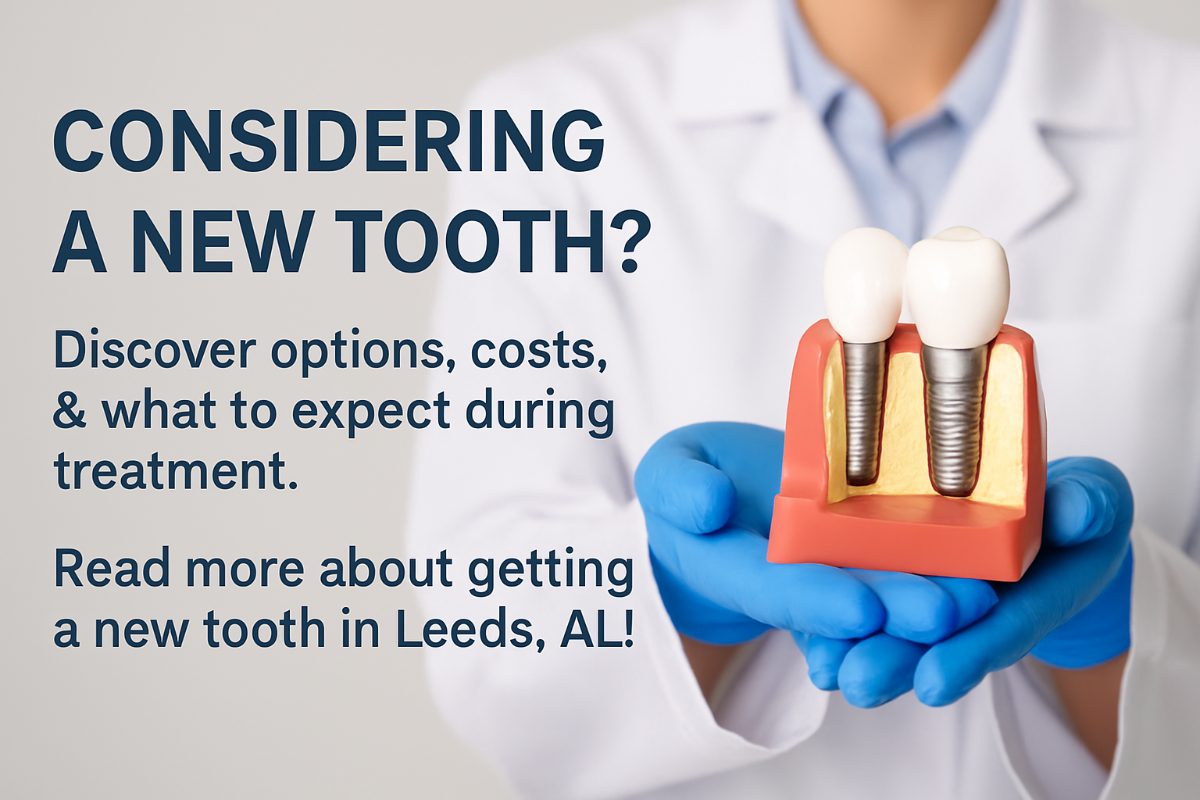Thinking about getting a new tooth? This guide explains what to expect from tooth replacement options, timelines, comfort, risks, cost, and clear next steps. Whether you’re seeing a dentures dentist or an implant specialist, you’ll learn practical differences between options, how treatment is planned, what the implant process looks like, and questions to ask at your first visit.
What “new tooth” means: common replacement options
“New tooth” can mean several things depending on your needs.
- Single dental implant: a titanium post placed in the jaw with an implant crown on top. Best for one missing tooth. Pros: natural feel and long-term. Cons: higher upfront cost and surgical healing time.
- Implant-supported crown: similar to a single implant but used when extra support is needed. Good when adjacent teeth are healthy.
- Implant bridge: two or more implants support multiple replacement teeth. Used when several teeth in a row are missing.
- Removable dentures: traditional plate-style teeth that come out. Pros: lower cost and quick replacement. Cons: less stability, possible slippage, and more maintenance.
- All-on-4 full-arch solutions: four or more implants support a full arch of teeth. Good for patients replacing all teeth on one arch. Pros: fixed feel and strong function. Cons: larger initial treatment but often faster overall recovery than placing many single implants.
How to know if you need a new tooth
Common signs you may need a replacement:
- Pain from a cracked or badly infected tooth
- A tooth that can’t be saved after repairs
- A missing tooth causing bite changes or shifting teeth
- Difficulty chewing or speaking
- Cosmetic concerns that affect confidence
Most dentists try tooth-saving treatments (root canal, crowns) first when possible. Replacement is considered when saving the tooth isn’t viable or would cause long-term problems.
Before treatment: consultation and planning
At your consult, the dentist reviews your medical history, current meds, and does an oral exam. Digital imaging like CBCT scans shows bone volume and nerve locations. The dentist explains options, timelines, estimated costs, and sedation choices.
Good questions to ask: What are my options? How many visits and how long will it take? What are the risks and success rates? Will I need bone grafting? Is sedation available?
Step-by-step: getting a dental implant for your new tooth
Placement surgery
Surgery usually takes one visit. You’ll get local anesthesia, and options include nitrous or oral/IV sedation for extra comfort. The implant post is placed into the jawbone where the tooth was, and the site is closed for healing.
Healing & osseointegration
Over 3–6 months the bone fuses to the implant (osseointegration). Expect light swelling and avoid hard foods. Some patients receive a temporary crown or bridge to keep function and appearance during healing.
Restoration
After healing, an abutment is placed and a final crown is made. Many practices offer same-day crowns with CEREC or in-house labs, while others use lab-made crowns that arrive in a couple of weeks. The final crown is matched for color and bite.
Pain, recovery, and day-to-day aftercare
Pain is usually mild to moderate and controlled with over-the-counter ibuprofen or prescription meds if needed. Common side effects include swelling, minor bleeding, and bruising. Eat soft foods for several days and keep the area clean with gentle rinsing. Avoid smoking during healing to reduce failure risk.
Risks and how dentists prevent problems
Possible complications: infection, implant failure, nerve irritation, or sinus issues in the upper jaw. Dentists reduce risks with careful imaging (CBCT), guided surgery, sterile technique, and experienced surgical skill. Follow-up visits catch problems early.
Who is a good candidate for a new tooth?
Good candidates have adequate bone volume, healthy gums, and controlled medical conditions. Smoking, uncontrolled diabetes, or active gum disease can affect success. Bone grafting or sinus lifts can rebuild volume so implants are possible for many patients.
Cost, insurance, and payment options
Costs vary by treatment: a single tooth implant is generally less than multiple implants or full-arch work. Factors include implant brand, need for grafting, lab fees, and sedation. Insurance may cover parts of restoration or dentures but often not full implant costs. Many practices offer financing, monthly payment plans, or third-party credit to spread payments.
Why consider Koplon Implant & Family Dentistry for your new tooth
Koplon Implant & Family Dentistry serves Leeds with an in-house digital lab and CEREC same-day crown capability. The team has All-on-4 expertise and offers DOCS-certified sedation for comfort. The father-and-son leadership coordinates surgical and restorative care so much of the treatment happens under one roof.
What to bring to your appointment and common questions to ask
- Bring your medical history, list of current medications, and prior X-rays if available
- Ask about the dentist’s implant experience and success rates
- Confirm expected timeline, number of visits, sedation options, and warranty on work
- Discuss cost estimates, insurance billing, and payment plan details
Next steps / Call to action
If you’re ready to explore a new tooth, schedule a consult with a trusted dentures dentist Leeds, AL or implant team. At your first visit the dentist will explain personalized options, timelines, and costs so you can choose the right path forward. Call the office or request an appointment to start planning your new tooth with confidence.





